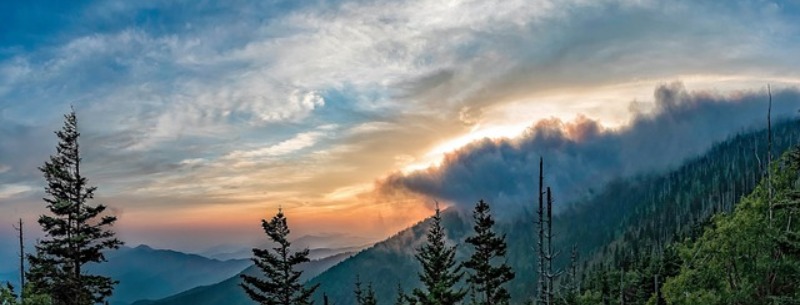Great Smoky Mountains Visitors Guide
The Great Smoky Mountains National Park is located in southeastern Tennessee and borders North Carolina on its western side. The Park was given its name because of the perpetual fog that lingers over the valleys and peaks that make up this part of the Appalachian Mountains.
When we think of exciting national park experiences, we usually think of Yosemite and the other great national parks out west. Yet, the Smoky Mountain National Park is America’s most visited and most enjoyed national park every year. From the hundreds of miles of trails and streams waiting to be explored to over 17,000 species of wildlife, the park’s terrain offers a wide range of exciting options for your next vacation.
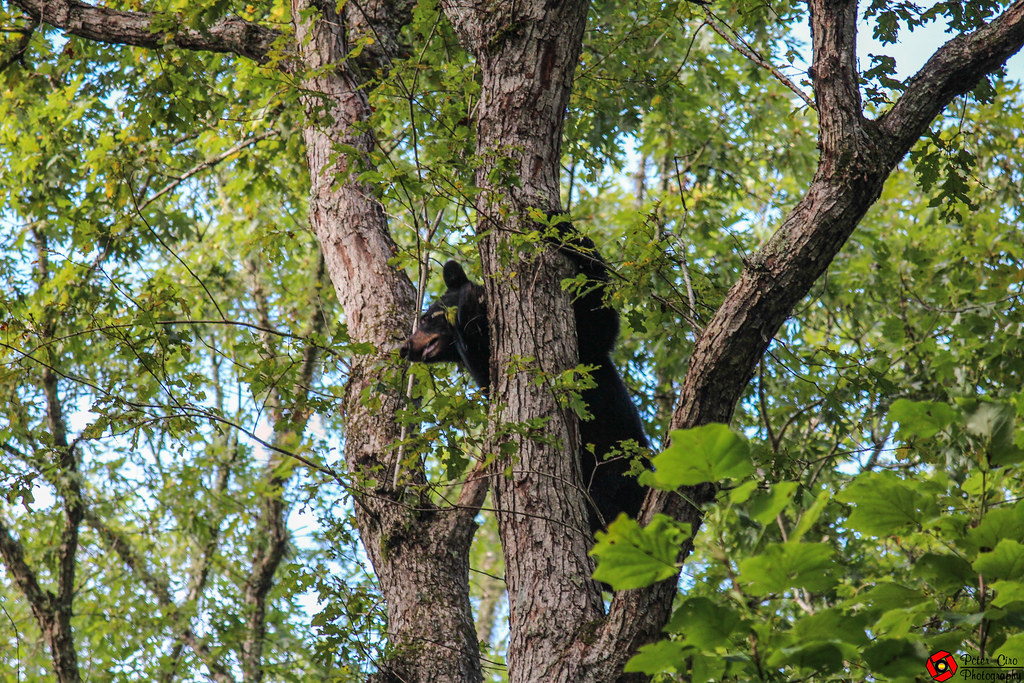
Let’s start with wildlife. Most people today have never seen a Black Bear in their natural habitat. The Smoky Mountain National Park is home to an estimated 1,500 of these bears along with an abundance of white-tailed deer, raccoons, turkeys, and woodchucks, among thousands of other wildlife species you will never find in such a pristine setting as the Great Smoky Mountain National Park. This is your chance to let the young and old alike actually see and enjoy true American wildlife.
Smoky Mountain National Park consists of more than half a million acres and is home to a wide array of wildlife and more than four thousand plant species. Black bears can be seen on many of the trails in the Park and quite frequently in Cades Cove and some campgrounds. Despite their cuddly, teddy-bear appearance, beware, they are not to be approached or fed.
Once a part of the Cherokee Indian homestead, the Great Smoky Mountains National Park of today is a hiker’s paradise with over 800 miles of walking trails within the Park’s borders. There is a mix of hiking trail levels for those who are just out for a nature walk to those who are serious hikers and climbers. You can even get backcountry permits to hike some of the more obscure trails not open to the general public.
The Great Smoky Mountains National Park is the most visited National Park in the entire country, with more than nine million visitors each year. You will want to plan out your adventure when visiting, as traffic tends to get congested in some of the more popular areas, especially during the peak summer months in North Carolina.
The Great Smoky Mountains National Park is bordered by the towns of Gatlinburg, Pigeon Forge, and Townsend on the Tennessee side and by Maggie Valley and Cherokee on the North Carolina side. Each town offers a diverse mix of attractions, shopping, dining, lodging, and of course, great southern fun for the entire family.
Smoky Mountain National Park is also home to Cades Cove, one of the most serene and beautiful locations in the eastern United States. Cades Cove is a must-see if you are anywhere near the Great Smoky Mountains National Park during your travels through North Carolina. The highlight of Cades Cove is the eleven-mile loop that encircles the mountain’s valley. To get a glimpse of some of the Smokies’ wildlife, it’s best to plan your trip around the loop early in the morning or at dusk.
Cades Cove
Cades Cove in the Smokies is probably one of the most visited areas in the park. The eleven-mile Cades Cove Loop road is used by cars, bicycles, and pedestrians. The loop is a restful way to see lush fields, old homesteads, and plentiful wildlife. Cades Cove bike rides are very popular and, during the summer and fall, the loop is closed to automobiles on Wednesday mornings so that cyclists can enjoy the scenery. Full-moon bicycle rides also have quite a following. It’s not unusual for Cades Cove visitors to see whitetail deer, black beer, raccoons or other wild animals. The whitetail deer are fairly used to people and are often photographed in this wondrous area while the black bears have been known to cause small traffic jams as people slow down to get a better look.
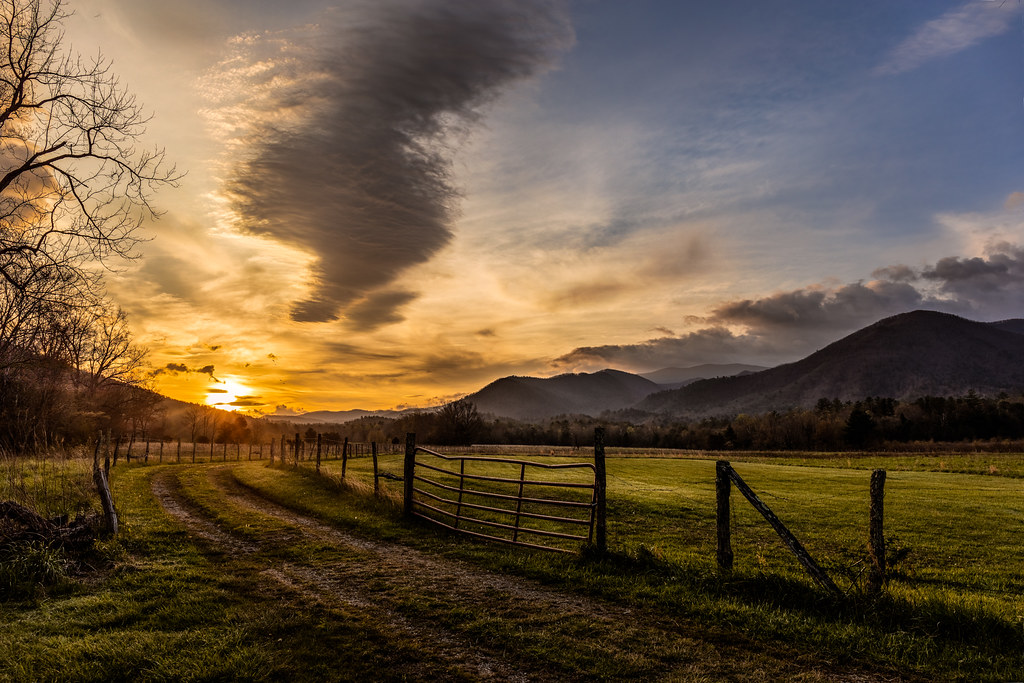
Cades Cove camping is readily available and many people bring their bicycles and hiking gear along. One of the first historical sites along the Cades Cove Loop is John Oliver Place. The Olivers settled in Cades Cove in 1826 and the site belonged to the family until the park was established. The John Oliver cabin is typical of an 1850s frontier home. Further down the road, the Primitive Baptist Church stands. It is a mile or so from the John Oliver Place and served the needs of the local settlers until 1887. The cemetery is of special interest as it hints at the difficulties of life at that time. The Methodist Church hails further down the loop. Reportedly built in 115 days by one man for $115, the church held services in this one-room, segregated building until 1902.
The Cades Coves Nature Trail is a short walk from the loop and looks at the area with a settler’s eye. People who settled in this cove had to make their living from the land and the nature trail points out various materials that a settler would need and find important. Toward the end of the loop is the Carter-Shields Cabin, also called the Carter-Shields Cabin. The Shields was one of the founding families of Cades Cover and this cabin is a reminder of both the simplicity and difficulty of early life in the cove. Cades Cove in the Smokies offers a view of nature and history and is a must-see when visiting the park.
Smoky Mountain Attractions
The reasons to take a Smoky Mountain vacation are numerous. The mountains are beautiful, the towns are friendly and interesting and the range of attractions in the Smokies is immense. Smokey Mountain attractions include the City of Gatlinburg which has a lively, walkable downtown featuring local candy companies (making candy in their windows), museums, shopping galore, restaurants, and lodging as well as year-round ice skating and seasonal skiing. Other towns of interest are Pigeon Forge and Sevierville, both of which draw millions of people each year to their outlet shopping centers and country music theaters. Smoky Mountain attractions also include the mountains themselves. Sure, there’s a lot to do in town, but the mountains have a life as well. Wildlife, scenic vistas, rare orchids, and waterfalls are just a few of the attractions in the Smokies, while hiking and camping are popular themes for Smoky Mountain vacations. Here are some suggested Smoky Mountain attractions.
Scenic Helicopter Tours
Scenic Helicopter Tours will show you from the majestic grandeur of Mount Le Conte to the pristine serenity of Douglas Lake, and give you a Smoky Mountain experience unlike any other! Let Scenic’s courteous staff take you on a family-friendly adventure of a lifetime. With rides starting at only $10.00 per person and up, Scenic Helicopter Tours makes that special Smoky Mountain getaway even more magical. Breath-taking aerial weddings, romantic mountain tours, kid-friendly experience rides or customize your own flight. Whatever you decide, Be sure to bring along your camera and prepare for an unforgettable experience!
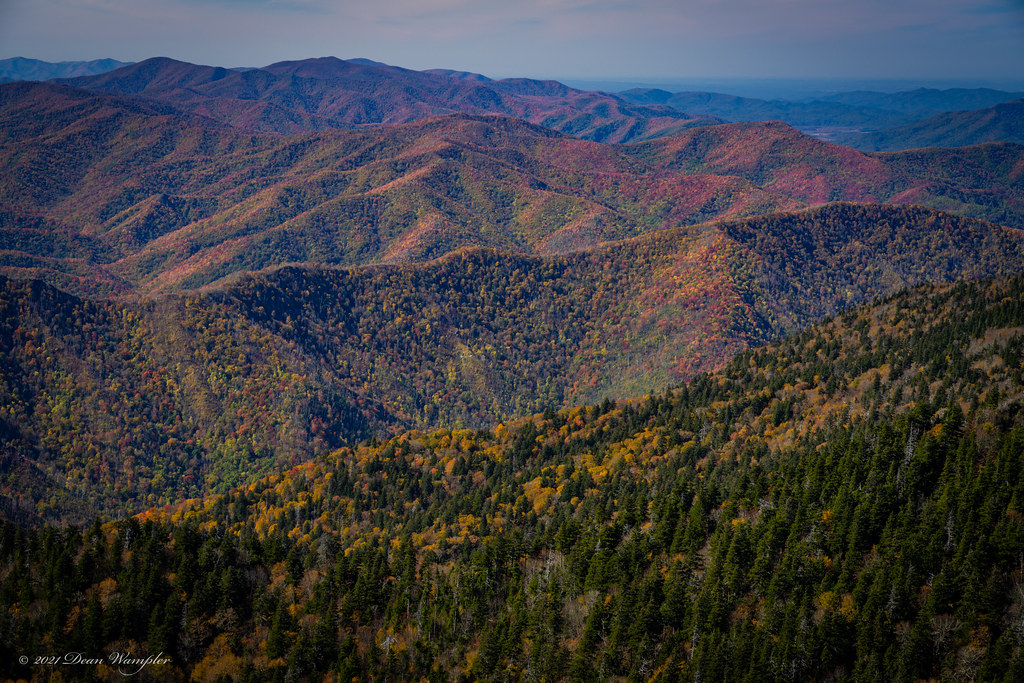
Rainforest Adventures Discovery Zoo
 Rainforest Adventures Discovery Zoo is located in the heart of the beautiful Smoky Mountains of Tennessee, near both Gatlinburg and Pigeon Forge, this all indoor RainForest Zoo is open year-round. Mixing fun with education the RainForest has been themed by one of the nation’s finest zoological contractors, whose work includes the Animal Kingdom at Disney World. Featuring over 400 live animals, representing over 130 species, we are home to unique and beautiful creatures from the Rain Forests of the world. Click here to purchase your tickets online.
Rainforest Adventures Discovery Zoo is located in the heart of the beautiful Smoky Mountains of Tennessee, near both Gatlinburg and Pigeon Forge, this all indoor RainForest Zoo is open year-round. Mixing fun with education the RainForest has been themed by one of the nation’s finest zoological contractors, whose work includes the Animal Kingdom at Disney World. Featuring over 400 live animals, representing over 130 species, we are home to unique and beautiful creatures from the Rain Forests of the world. Click here to purchase your tickets online.
Waterfalls in The Smokies
Many people make a point to visit at least one of the Smoky Mountain waterfalls when they visit the park. Although most of the waterfalls in the Smokies are a short hike away, Meigs Falls is one that is visible from the road. Meigs Falls is located 12.5 miles from the Sugarland Visitor Center and is a stunning 28-foot fall. The easiest fall to reach on foot is Laurel Falls. It is only a 1.25-mile (2.5 round trip) walk on a trail that is both paved and relatively flat. It’s a small price to pay for the reward of seeing Laurel Falls’ beautiful 60-foot cascade. Another waterfall within a short walk is Grotto Falls. The 2.5-mile round-trip trail winds easily through a hemlock forest to arrive at a lovely 25-foot waterfall. Grotto Falls has the distinction of being the only falls that one can walk under. A slightly more strenuous hike is to Rainbow Falls. It’s a five-and-a-half-mile round trip on a moderate trail, but the reward is an incredible 60-foot waterfall.

The highest waterfall in the park is Ramsey Cascades. The hike to the falls is eight miles (round trip) of moderate to active walking, but the waters of Ramsey Cascades plunge a dramatic 80 feet. At 150 feet, Mingo Falls is the highest waterfall bordering the park. It’s also the shortest walk. The trail to the falls is only a quarter of a mile, mostly stairs and can be a bit demanding. However, Mingo Falls is a spectacular sight, especially after heavy rain. One of the most popular waterfalls in the Smokies is Abrams Falls. Located in Cades Cove, it is a moderate 2.5-mile (5-mile round trip) walk from the loop road to the falls. Abrams Falls, an enticing 20 ft. waterfall with a large swimming hole at its base is a crowd-pleasing picnic and swimming area in the summer months. There are many other Smoky Mountain waterfalls, but these are some of the better-known attractions.
Hiking in the National Park, Tennessee
Hiking in the Smoky Mountains is one of the greatest pleasures of visiting this area. The Smoky Mountain trails are so vast that one could hike for years and never walk all 900-plus miles. Smoky Mountain hiking is a beloved pastime for many local residents. Any out-of-towner on the trail is likely to run into a local if they run into anyone at all. Probably the most recognized trail in the Smokies is the Appalachian Trail. This 2160-mile trek runs from Georgia to Maine. Many of the Smoky Mountain park trails either cross the Appalachian Trail or follow it for a few miles. One of the shorter Smoky Mountain hiking trails is the Abram Falls Trail. Located in Cades Cove, it is a moderate 2.5 mile (5 miles round trip) trail leading to Abrams Falls, a beautiful 20 ft. waterfall with a large swimming hole at its base. Perfect for a picnic and swimming in the summer months!
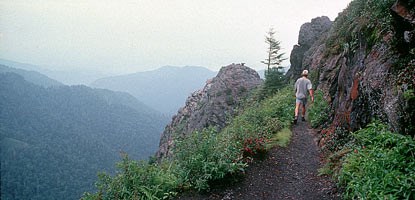
Another easy-to-moderate trail is the Albright Grove Trail outside of Cosby. This loop trail is 3.5 miles one way and passes through one of the most stately and largest stands of virgin poplar in the Southeastern region. A slightly longer trail is the Alum Cave Bluffs Trail. This trail is a short 5.5-mile trail (round trip) and ends at a 100-foot bluff rather than a cave. Rumor marks that the bluff as a source of saltpeter for Civil War gunpowder. Continue another 2.9 miles past the bluff and visit Mount LeConte, one of the highest mountains in the Smokies, with stunning, scenic views. A number of different trails lead to Mt. LeConte although the shortest one is the Alum Cave Bluff Trail.
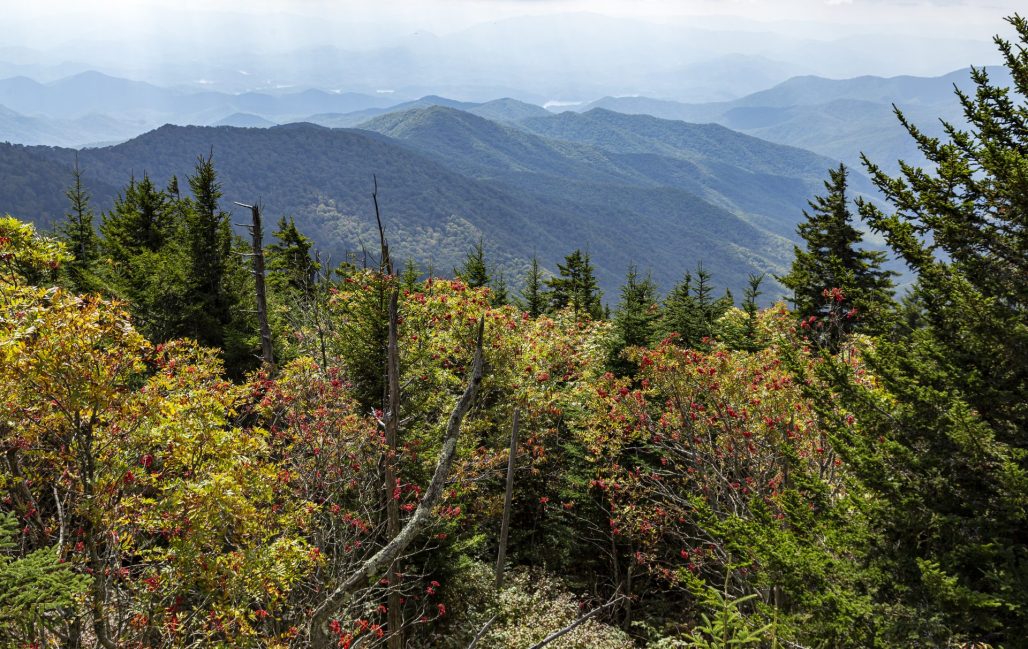
Clingmans Dome
The shortest trail might be to Clingman Dome. It’s only a steep half-mile to this observation tower, though it leads to the highest point in the Great Smoky Mountain National Park. Clingmans Dome is one of the most popular park destinations.
Sugarland Mountain Trail
How about a longer day hike? The Sugarland Mountain Trail is 11 miles one way. It’s a slightly strenuous hike, but not very steep, and features several gorgeous views while winding through the different types of forests in the park. Smoky Mountain hiking trails offer something for everyone.
Cabins and Chalets in the Smoky Mountains
Lodging in the Smokies abounds with luxury rental cabins, chalets, and cottages featuring the comforts of home in the beauty of the mountains. Most of the rental cabins in the Smokies are in the towns that border or are in close proximity to the national park such as Pigeon Forge, Gatlinburg, Sevierville or Wears Valley. Smoky Mountain cabins are available in a wide range of sizes, styles, and prices and offer something for everyone.
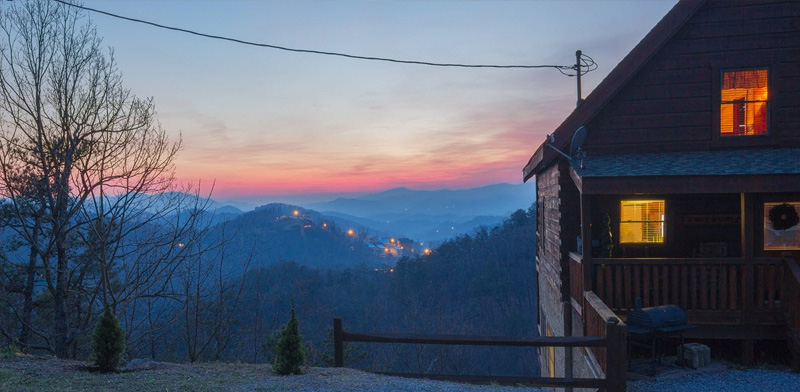
Many Smoky Mountain cabins are secluded and offer beautiful views along with amenities like observation decks or hot tubs. Others provide easy access to hiking trails. Still, others are closer to urban areas and provide the shopping and nightlife experience yet are still near enough to the National Park to facilitate an easy get-a-way. The variety of Smokies rental cabins and other Smoky Mountain lodgings assure that a visitor can find the perfect fit for the perfect vacation. Here are several companies that specialize in Smoky Mountain cabins.
>> More at Smoky Mountain Cabin Rentals Guide
Camping in the Great Smoky Mountains
When camping comes to mind there is only one word that can describe it and that word is isolation, quietness, serenity, noise-free, hammocks, clear skies, stars in the heavens, private, outdoors, and isolation. OK, I admit, it can’t be described in just one word. It is like a picture is worth a thousand words! It is indescribable unless you experience it. And to experience camping at its best, the BEST is found in The Great Smoky Mountains and in The National Park with 10 great camping locations ready to impact your adventurous life. Imagine, for a moment, that you have the awesome privilege of selecting from over 925 miles of superlative trails, tracts of untouched forest land, observing over 4,000 species of plants, over 65 mammals, birds that number into the hundreds, and course if you are fortunate enough, you might look up into a tree and glimpse a famous black bear staring down at you, but that’s rare.
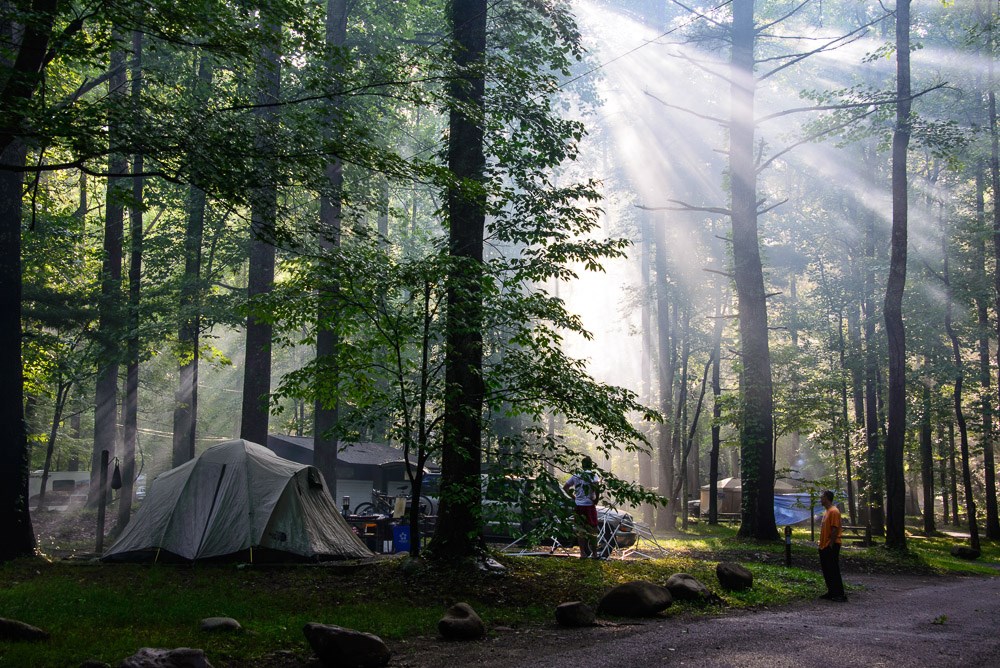
Let’s get started! The array in campground size is huge, from the massive Elkmont to the miniature Big Creek. There is something for every J.S. Camper. The Smoky Mountain National Park maintains 10 great camping locations within the park.
| Campsite | Elevation | # of sites |
|---|---|---|
| Abrams Creek | 1,125 feet | 16 sites |
| Balsam Mountain | 5,310 feet | 46 sites |
| Big Creek | 1,700 feet | 12 sites |
| Cades Cove | 1,807 feet | 159 sites |
| Cataloochee | 2,610 feet | 27 sites |
| Cosby | 2,459 feet | 165 sites (most popular) |
| Deep Creek | 1,800 feet | 92 sites |
| Elkmont | 2,150 feet | 220 sites |
| Look Rock | 2,600 feet | 68 sites |
| Smokemont | 2,198 feet | 142 sites |
The nearest place for outdoor splendor and fun is Abrams Creek which is on the western perimeter of the park. Sheltered on each side you will find considerable amounts of hemlock and white pine. Because of its size and beauty, it is a favorite among the locals in Pigeon Forge and Gatlinburg, Tennessee. Plenty of trails will line the area of Abrams Creek and even when it is crowded it still seems quiet!
Cades Cove
Cades Cove is noted for the amazing scenery and abundance of deer that graze in the meadow. This campground is very popular for families. Bring your bike on this trip as you will travel the 11-mile circumference of the park before you settle into camp.
Big Creek
Big Creek is an intimate campsite. Though it is the smallest among the 10 campsites of The National Park in The Great Smoky Mountains, it is in the midst of a deep forest. Only bring your tent to this campsite. Oh, and remember, all of the campsites within the National Park have electricity and bathroom facilities. Campsites range in fees from $14 to $23 per site.
Cataloochee Valley
Similar to Cades Cove is Cataloochee Valley. You will find many historic buildings along the trails of this great camping area. You will find only dirt roads to this destination. You will want to grab hold of the Cataloochee Valley campsite on the east side, with fewer crowds.
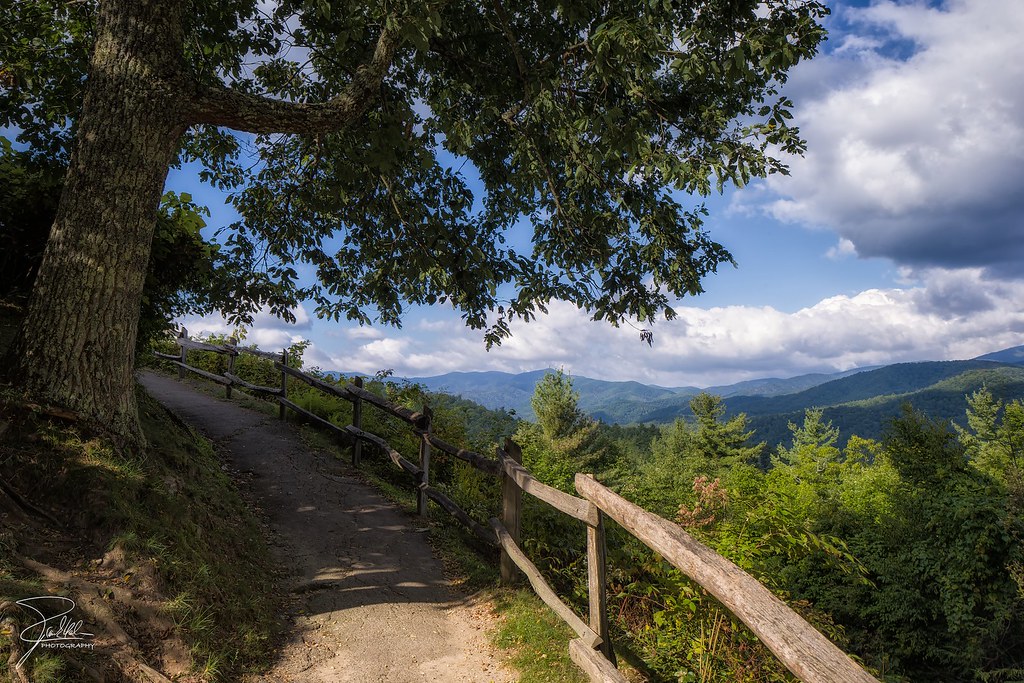
Cosby
Cosby is the superior and the gem of all campsites in the Great Smoky National Park. Even though it is the most popular it is seldom overcrowded. When, on rare occasions that Cosby is crowded, it is very quiet and reserved. You will not be disappointed with so much to see and do. If you are a camper, this one is for you.
For more information on the campsites of the Great Smoky Mountains, you may call toll-free at (800) 365-CAMP. There are regulations concerning food storage, generator use, and quiet hours. Remember again that each campsite and campground has restrooms with cold running water and flush toilets, but there are no showers or electrical or water hookups in the park. Shower facilities are available in the communities surrounding the national park.
Final Word
There is an endless amount of activities to enjoy while visiting the Smoky Mountain National Park such as biking, camping, hiking, wildlife watching, tubing or white water rafting and a whole lot more.
Plan your visit today! Enjoy favorite destinations such as Cade’s Cove, Roaring Fork, and Clingman’s Cove as thousands of people do every year. Tired of that same old trip to the beach with the scorching sun and smells of suntan oil? Get real at Smoky Mountain National Park.
Come visit the Great Smoky Mountains National Park in North Carolina or Tennessee and experience a true family-friendly locale, and discover why more than 9 million people vacation in this serene mountain paradise each and every year.
